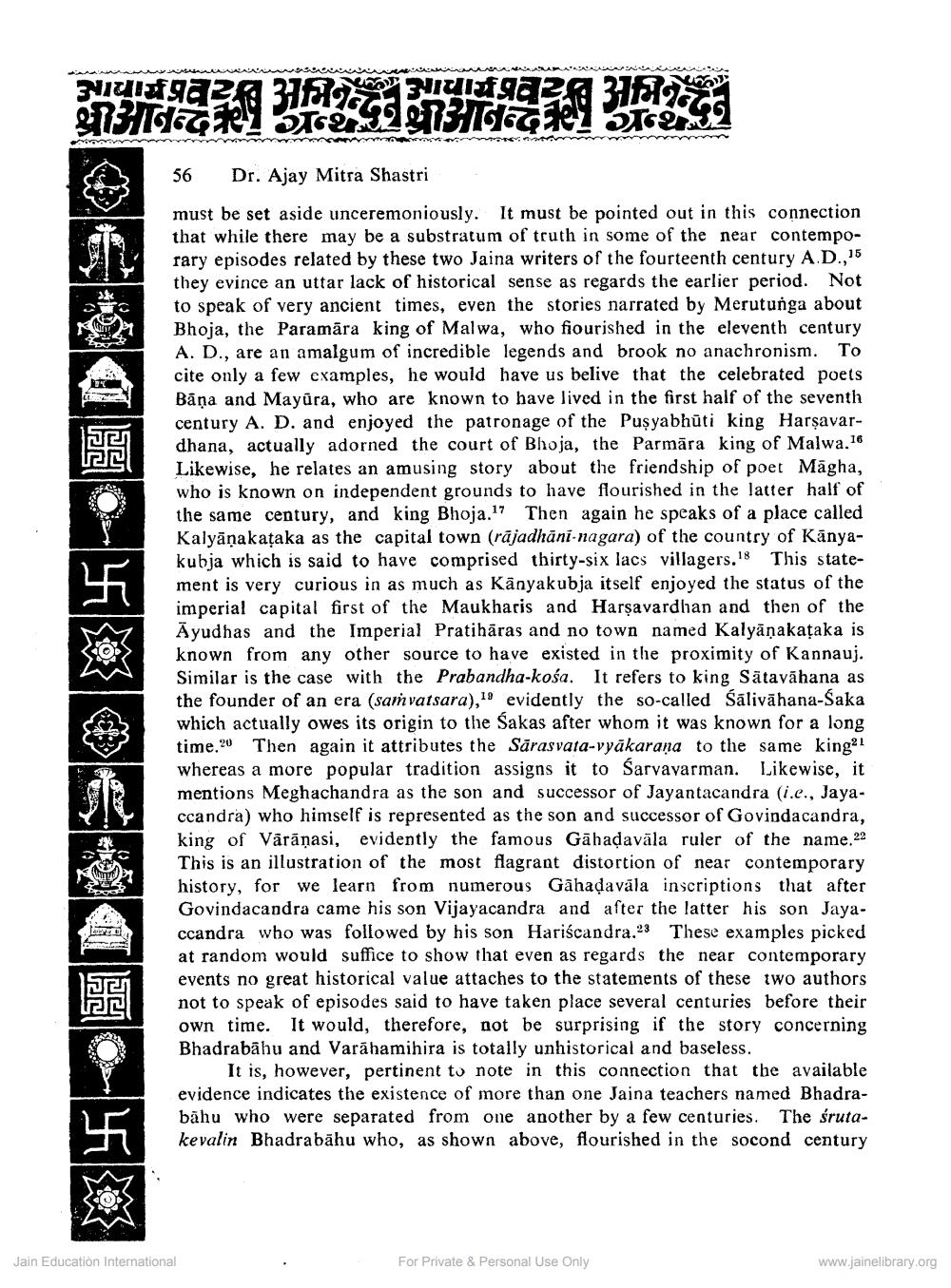Book Title: Varahamihira and Bhadrabahu Author(s): Ajay Mitra Shastri Publisher: Z_Anandrushi_Abhinandan_Granth_012013.pdf View full book textPage 5
________________ A AAAAAAAAAAAAAAAAAAAAAAAAAAAAAA Niiga 23 1999 3 3111 ISATGE STA90311 Geely 515242 56 Dr. Ajay Mitra Shastri must be set aside unceremoniously. It must be pointed out in this connection that while there may be a substratum of truth in some of the near contemporary episodes related by these two Jaina writers of the fourteenth century A.D.,15 they evince an uttar lack of historical sense as regards the earlier period. Not to speak of very ancient times, even the stories narrated by Merutunga about Bhoja, the Paramāra king of Malwa, who fiourished in the eleventh century A. D., are an amalgum of incredible legends and brook no anachronism. To cite only a few examples, he would have us belive that the celebrated poets Bāņa and Mayūra, who are known to have lived in the first half of the seventh century A. D. and enjoyed the patronage of the Pusyabhūti king Harşavardhana, actually adorned the court of Bhoja, the Parmāra king of Malwa. 16 Likewise, he relates an amusing story about the friendship of poet Māgha, who is known on independent grounds to have flourished in the latter half of the same century, and king Bhoja. Then again he speaks of a place called Kalyāņakataka as the capital town (rājadhāni-nagara) of the country of Kānyakubja which is said to have comprised thirty-six lacs villagers.18 This statement is very curious in as much as Kanyakubja itself enjoyed the status of the imperial capital first of the Maukharis and Harşavardhan and then of the Ayudhas and the Imperial Pratihāras and no town named Kalyāņakațaka is known from any other source to have existed in the proximity of Kannauj. Similar is the case with the Prabandha-kośa. It refers to king Sātavāhana as the founder of an era (samvatsara),19 evidently the so-called Salivāhana-Saka which actually owes its origin to the Sakas after whom it was known for a long time.20 Then again it attributes the Sārasvata-vyākarana to the same king 1 whereas a more popular tradition assigns it to Sarvavarman. Likewise, it mentions Meghachandra as the son and successor of Jayantacandra (i.e., Jaya. ccandra) who himself is represented as the son and successor of Govindacandra, king of Vārāṇasi, evidently the famous Gāhadavāla ruler of the name 22 This is an illustration of the most flagrant distortion of near contemporary history, for we learn from numerous Gahadavāla inscriptions that after Govindacandra came his son Vijayacandra and after the latter his son Jayaccandra who was followed by his son Hariscandra.23 These examples picked at random would suffice to show that even as regards the near contemporary events no great historical value attaches to the statements of these two authors not to speak of episodes said to have taken place several centuries before their own time. It would, therefore, not be surprising if the story concerning Bhadrabāhu and Varāhamihira is totally unhistorical and baseless. It is, however, pertinent to note in this connection that the available evidence indicates the existence of more than one Jaina teachers named Bhadrabāhu who were separated from one another by a few centuries. The śrutakevalin Bhadrabāhu who, as shown above, flourished in the socond century Jain Education International For Private & Personal Use Only www.jainelibrary.orgPage Navigation
1 ... 3 4 5 6 7 8 9 10 11 12 13 14 15 16 17 18 19 20
